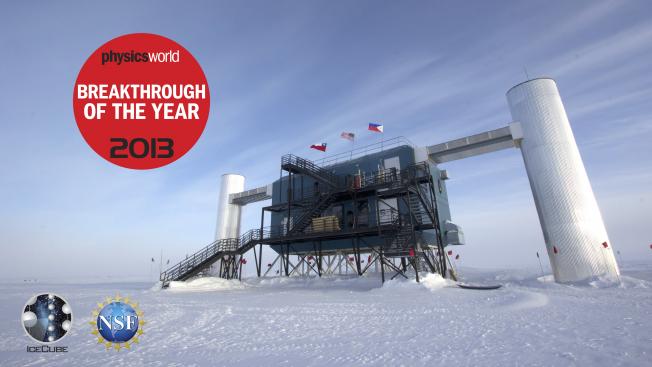Multipole analysis of IceCube data to search for dark matter accumulated in the Galactic halo
European Physical Journal C Springer Berlin Heidelberg C75:1 (2015) 20-20
Abstract:
Dark matter which is bound in the Galactic halo might self-annihilate and produce a flux of stable final state particles, e.g. high energy neutrinos. These neutrinos can be detected with IceCube, a cubic-kilometer sized Cherenkov detector. Given IceCube's large field of view, a characteristic anisotropy of the additional neutrino flux is expected. In this paper we describe a multipole method to search for such a large-scale anisotropy in IceCube data. This method uses the expansion coefficients of a multipole expansion of neutrino arrival directions and incorporates signal-specific weights for each expansion coefficient. We apply the technique to a high-purity muon neutrino sample from the Northern Hemisphere. The final result is compatible with the null-hypothesis. As no signal was observed, we present limits on the self-annihilation cross-section averaged over the relative velocity distribution $<\sigma v>$ down to $1.9\cdot 10^{-23}\,\mathrm{cm}^3\mathrm{s}^{-1}$ for a dark matter particle mass of $700\,\mathrm{GeV}$ to $1000\,\mathrm{GeV}$ and direct annihilation into $\nu\bar{\nu}$. The resulting exclusion limits come close to exclusion limits from $\gamma$-ray experiments, that focus on the outer Galactic halo, for high dark matter masses of a few TeV and hard annihilation channels.Searches for small-scale anisotropies from neutrino point sources with three years of IceCube data
Astroparticle Physics Elsevier 66 (2015) 39-52
Abstract:
Recently, IceCube found evidence for a diffuse signal of astrophysical neutrinos in an energy range of $60\,\mathrm{TeV}$ to the $\mathrm{PeV}$-scale. The origin of those events, being a key to understanding the origin of cosmic rays, is still an unsolved question. So far, analyses have not succeeded to resolve the diffuse signal into point-like sources. Searches including a maximum-likelihood-ratio test, based on the reconstructed directions and energies of the detected down- and up-going neutrino candidates, were also performed on IceCube data leading to the exclusion of bright point sources. In this paper, we present two methods to search for faint neutrino point sources in three years of IceCube data, taken between 2008 and 2011. The first method is an autocorrelation test, applied separately to the northern and southern sky. The second method is a multipole analysis, which expands the measured data in the northern hemisphere into spherical harmonics and uses the resulting expansion coefficients to separate signal from background. With both methods, the results are consistent with the background expectation with a slightly more sparse spatial distribution, corresponding to an underfluctuation. Depending on the assumed number of sources, the resulting upper limit on the flux per source in the northern hemisphere for an $E^{-2}$ energy spectrum ranges from $1.5 \cdot 10^{-8}\,\mathrm{GeV}/(\mathrm{cm}^2 \mathrm{s})$, in the case of one assumed source, to $4 \cdot 10^{-10} \,\mathrm{GeV}/(\mathrm{cm}^2 \mathrm{s})$, in the case of $3500$ assumed sources.Atmospheric and astrophysical neutrinos above 1 TeV interacting in IceCube
Physical Review D American Physical Society D91:2 (2015) 022001-022001
Abstract:
The IceCube Neutrino Observatory was designed primarily to search for high-energy (TeV--PeV) neutrinos produced in distant astrophysical objects. A search for $\gtrsim 100$~TeV neutrinos interacting inside the instrumented volume has recently provided evidence for an isotropic flux of such neutrinos. At lower energies, IceCube collects large numbers of neutrinos from the weak decays of mesons in cosmic-ray air showers. Here we present the results of a search for neutrino interactions inside IceCube's instrumented volume between 1~TeV and 1~PeV in 641 days of data taken from 2010--2012, lowering the energy threshold for neutrinos from the southern sky below 10 TeV for the first time, far below the threshold of the previous high-energy analysis. Astrophysical neutrinos remain the dominant component in the southern sky down to 10 TeV. From these data we derive new constraints on the diffuse astrophysical neutrino spectrum, $\Phi_{\nu} = 2.06^{+0.4}_{-0.3} \times 10^{-18} \left({E_{\nu}}/{10^5 \,\, \rm{GeV}} \right)^{-2.46 \pm 0.12} {\rm {GeV^{-1} \, cm^{-2} \, sr^{-1} \, s^{-1}} } $, as well as the strongest upper limit yet on the flux of neutrinos from charmed-meson decay in the atmosphere, 1.52 times the benchmark theoretical prediction used in previous IceCube results at 90\% confidence.Full-sky analysis of cosmic-ray anisotropy with IceCube and HAWC
Proceedings of Science 30-July-2015 (2015)
Abstract:
During the past two decades, experiments in both the Northern and Southern hemispheres have observed a small but measurable energy-dependent sidereal anisotropy in the arrival direction distribution of galactic cosmic rays. The relative amplitude of the anisotropy is 10-4 -10-3. However, each of these individual measurements is restricted by limited sky coverage, and so the pseudo-power spectrum of the anisotropy obtained from any one measurement displays a systematic correlation between different multipole modes C. To address this issue, we present the preliminary status of a joint analysis of the anisotropy on all angular scales using cosmic-ray data from the IceCube Neutrino Observatory located at the South Pole (90 S) and the High-Altitude Water Cherenkov (HAWC) Observatory located at Sierra Negra, Mexico (19 N). We describe the methods used to combine the IceCube and HAWC data, address the individual detector systematics and study the region of overlapping field of view between the two observatories.Multipole analysis of IceCube data to search for dark matter accumulated in the Galactic halo: IceCube Collaboration
European Physical Journal C (2015)



